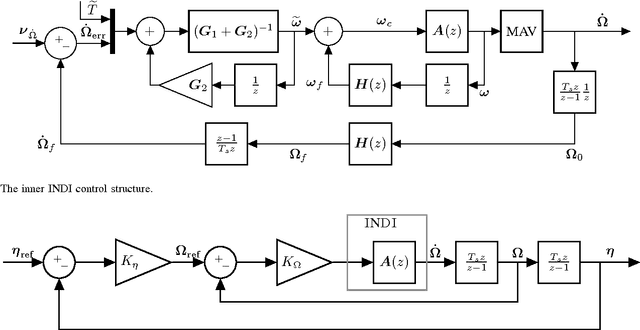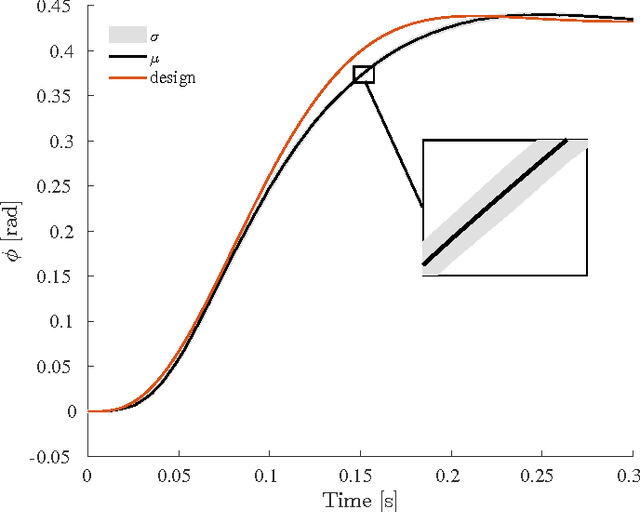Ewoud J. J. Smeur
Rapid and Inexpensive Inertia Tensor Estimation from a Single Object Throw
Mar 17, 2025Abstract:The inertia tensor is an important parameter in many engineering fields, but measuring it can be cumbersome and involve multiple experiments or accurate and expensive equipment. We propose a method to measure the moment of inertia tensor of a rigid body from a single spinning throw, by attaching a small and inexpensive stand-alone measurement device consisting of a gyroscope, accelerometer and a reaction wheel. The method includes a compensation for the increase of moment of inertia due to adding the measurement device to the body, and additionally obtains the location of the centre of gravity of the body as an intermediate result. Experiments performed with known rigid bodies show that the mean accuracy is around 2\%.
Design and Control of A Tilt-Rotor Tailsitter Aircraft with Pivoting VTOL Capability
Mar 04, 2025Abstract:Tailsitter aircraft attract considerable interest due to their capabilities of both agile hover and high speed forward flight. However, traditional tailsitters that use aerodynamic control surfaces face the challenge of limited control effectiveness and associated actuator saturation during vertical flight and transitions. Conversely, tailsitters relying solely on tilting rotors have the drawback of insufficient roll control authority in forward flight. This paper proposes a tilt-rotor tailsitter aircraft with both elevons and tilting rotors as a promising solution. By implementing a cascaded weighted least squares (WLS) based incremental nonlinear dynamic inversion (INDI) controller, the drone successfully achieved autonomous waypoint tracking in outdoor experiments at a cruise airspeed of 16 m/s, including transitions between forward flight and hover without actuator saturation. Wind tunnel experiments confirm improved roll control compared to tilt-rotor-only configurations, while comparative outdoor flight tests highlight the vehicle's superior control over elevon-only designs during critical phases such as vertical descent and transitions. Finally, we also show that the tilt-rotors allow for an autonomous takeoff and landing with a unique pivoting capability that demonstrates stability and robustness under wind disturbances.
Flying a Quadrotor with Unknown Actuators and Sensor Configuration
Sep 02, 2024Abstract:Though control algorithms for multirotor Unmanned Air Vehicle (UAV) are well understood, the configuration, parameter estimation, and tuning of flight control algorithms takes quite some time and resources. In previous work, we have shown that it is possible to identify the control effectiveness and motor dynamics of a multirotor fast enough for it to recover to a stable hover after being thrown 4 meters in the air. In this paper, we extend this to include estimation of the position of the Inertial Measurement Unit (IMU) relative to the Center of Gravity (CoG), estimation of the IMU rotation, the thrust direction of all motors and the optimal combined thrust direction. In order to guarantee a correct IMU position estimation, two prior throw-and-catches of the vehicle with spin around different axes are required. For these throws, a height as low as 1 meter is sufficient. Quadrotor flight experimentation confirms the efficacy of the approach, and a simulation shows its applicability to fully-actuated crafts with multiple possible hover orientations.
Control of Unknown Quadrotors from a Single Throw
Jun 17, 2024Abstract:This paper presents a method to recover quadrotor UAV from a throw, when no control parameters are known before the throw. We leverage the availability of high-frequency rotor speed feedback available in racing drone hardware and software to find control effectiveness values and fit a motor model using recursive least squares (RLS) estimation. Furthermore, we propose an excitation sequence that provides large actuation commands while guaranteeing to stay within gyroscope sensing limits. After 450ms of excitation, an INDI attitude controller uses the 52 fitted parameters to arrest rotational motion and recover an upright attitude. Finally, a NDI position controller drives the craft to a position setpoint. The proposed algorithm runs efficiently on microcontrollers found in common UAV flight controllers, and was shown to recover an agile quadrotor every time in 57 live experiments with as low as 3.5m throw height, demonstrating robustness against initial rotations and noise. We also demonstrate control of randomized quadrotors in simulated throws, where the parameter fitting RMS error is typically within 10% of the true value.
Cascaded Incremental Nonlinear Dynamic Inversion Control for MAV Disturbance Rejection
Jan 25, 2017



Abstract:Micro Aerial Vehicles (MAVs) are limited in their operation outdoors near obstacles by their ability to withstand wind gusts. Currently widespread position control methods such as Proportional Integral Derivative control do not perform well under the influence of gusts. Incremental Nonlinear Dynamic Inversion (INDI) is a sensor-based control technique that can control nonlinear systems subject to disturbances. It was developed for the attitude control of manned aircraft or MAVs. In this paper we generalize this method to the outer loop control of MAVs under severe gust loads. Significant improvements over a traditional Proportional Integral Derivative (PID) controller are demonstrated in an experiment where the quadrotor flies in and out of a windtunnel exhaust at 10 m/s. The control method does not rely on frequent position updates, as is demonstrated in an outside experiment using a standard GPS module. Finally, we investigate the effect of using a linearization to calculate thrust vector increments, compared to a nonlinear calculation. The method requires little modeling and is computationally efficient.
 Add to Chrome
Add to Chrome Add to Firefox
Add to Firefox Add to Edge
Add to Edge